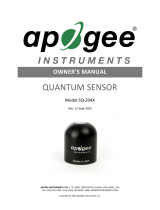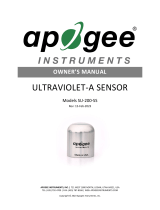Page is loading ...

Amplied
Pyranometer
Owners Manual
Model: PYR-PA
PYR-SA
2.5 and 5.0 V options
Pyranometer Sensor
This sensor is calibrated to measure
total shortwave radiation. The
evaporation of water from soil and
the transpiration of water from plant
leaves are partly determined by the
intensity of shortwave radiation, which
is measured in Joules m-2 s-1 or
Watts m-2.
The model, serial number, production
date, and calibration factor are located
on the sensor cable.
Red: positive (signal
from sensor)
Black: input power
Clear: ground (for sensor
signal and input power)
2.5 option 5.0 option
Power Supply 2.5 to 5.5 V 5.0 to 5.5 V
Conversion factor 0.5 W m-2
per mV
0.25 W m-2
per mV
Output (volts) 0.0 to 2.5 V 0.0 to 5.0 V
Full sunlight 2.2 V
(1100 W m-2)
4.4 V
(1100 W m-2)
Setup Instructions
US Patent No. D519,860
Do not exceed 5.5 Volts
in power supply.
Each sensor is equipped
with a mounting bolt.
Mount the sensor as
level as possible. Small
changes in level can cause
measurement errors. We
recommend using our
leveling plate (model LEV)
for the most accurate
measurements. The sensor
should be mounted with the
cable pointing toward the
nearest magnetic pole to
minimize azimuth error.
Model LEV
Mounting the PYR-PA and PYR-SA
Orientation
Bolt: 10-32x5/8
1
2 3

Calibration
Spectral Response and Calibration
An ideal pyranometer measures the entire solar
spectrum, 280 to 2800 nm. However, about 90% of
sunlight energy is between 300 to 1100 nm. Models
PYR-PA and PYR-SA are calibrated to estimate all of the
shortwave energy from sunlight. Apogee pyranometers
are calibrated under sunlight over a multiple day period
to a heated and ventilated Kipp & Zonen model CM21
precision reference radiometer.
Sensor Output
(4.4 V)
5.0 V
option
Full Sunlight
(1100 W m-2)
Sensor Output
(2.2 V)
solar radiation = sensor output x conversion factor
= 220 mV x 5.00 W m-2 per mV = 1100 W m-2
2.5 V
option
Conversion factor
(.250)
conversion factor
(.500)
Use the designated conversion
factor (.5 or .25 W m-2 per mV) to
convert the mV signal from the
sensor to shortwave radiation in
Watts m-2 (multiply the mV output
by the conversion factor to yield
shortwave radiation in W m-2).
Temperature response
The temperature response is less than 0.1% per degree Celsius.
This temperature error is not signicant in most applications.
Long-term stability
Our research indicates that the output increases about 1% per year
because of changes in the optical transparency of the diffusion disk.
We recommend returning the sensor for recalibration every 2 years.
Cosine Response Specications
Precision (PYR-PA) Standard (PYR-SA)
Cosine response 45° zenith angle ± 1 % ± 4 %
75° zenith angle ± 4 % ± 10 %
ABSOLUTE ACCURACY ± 5 % ± 8 %
REPRODUCIBILITY ± 1 % ± 2 %
2.5 V option Output 0 to 2.5 V (2.2 V = full sunlight 1100 W m-2)
Input power 2.5 to 5.5 VDC
Sensitivity Custom calibrated to exactly 0.50 W m-2 per mV
5.0 V option Output 0 to 5 V (4.4 V = full sunlight 1100 W m-2)
Input power 5 to 5.5 VDC
Sensitivity Custom calibrated to exactly 0.25 W m-2/ mV
OPERATING ENVIRONMENT - 40 to 55 °C; 0 to 100% relative humidity.
Designed for continuous outdoor use. Can be
submerged under water.
MATERIALS Anodized aluminum with acrylic lens
CABLE 3 meters of shielded, twisted-pair wire with
Santoprene casing, ending in pigtail leads.
Additional cable $1.95/meter.
DIMENSIONS 2.4 cm diameter, 2.75 cm high
MASS 70 g (with 3 m lead wire)
WARRANTY 1 year parts and labor
435-792-4700
www.apogeeinstruments.com
4 5
6 7
/









